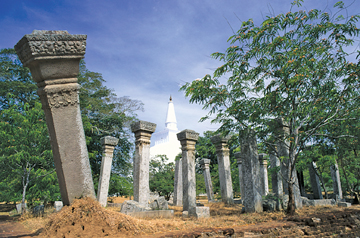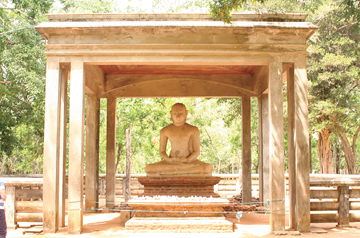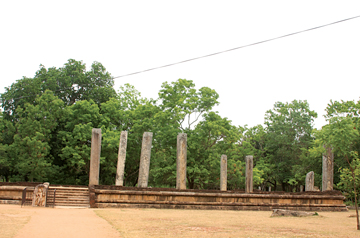Importance of the Maha Vihara
As far as historiography is concerned, the arrival of Buddhism, with
its unique institution of the self-renewing intellectual community of
monks and nuns, together called the Samgha, gave an unprecedented
stimulus. If the court historians recorded events to assert and maintain
national cultural identity, Buddhism found in historical recording two
major uses.
 |
| Ancient ruins
with the Ruwanweli Maha Seya in the background |

The Samadhi statute |
First, as Buddhism spread in and outside its region of origin, it
became necessary to establish the authenticity of its doctrine by
tracing the history of the linear descent of the tradition.
Second, Buddhism subsisted on public charity, and grateful recording
of services rendered to it was a sine qua non for drawing in more
donors.
If, with the introduction of Buddhism, Sri Lanka entered the phase,
which scholars tend to call 'writing history for a purpose', the benefit
has been remarkable.
Buddhism gave Sri Lankans a serene philosophy of life, which served
as an enduring source of inspiration for their creativity in art,
architecture and literature.
During the reign of Devanampiya Tissa, the establishment of two main
monasteries at Anuradhapura (Maha Vihara) and Mihintale (Cetiyapabbata)
and the construction of Thuparama as the first Stupa were followed by a
network of Buddhist shrines throughout the country at regular intervals
of seven or eight miles. Each of them was a veritable educational
institution where the Sangha exerted its remarkable role as an agent of
civilization.
The promotion of Buddhism came to be recognised consciously or
otherwise as the national mission. Thousands of early Brahmi
inscriptions recording donations to Buddhist shrines by people of all
races, classes and occupations testify to the extent of popular
patronage which Buddhism received.
A lasting contribution
Declaring his effort to be motivated by a commitment to promote
Buddhism, Dutthagamini Abhaya led a successful campaign against King
Elara, in Anuradhapura whom he slew in single combat.
His reign of twenty-four years (161-137 BC) saw the heyday of
Buddhism. He built the Mirisavatiya Stupa and set up a monastery around
it.
For the Maha Vihara, he constructed the Lovamahapaya (Brazen Palace),
the ten-storeyed, thousand-roomed dwelling place for monks.
The pinnacle of his achievements as a great builder was the
Ruvanvalisaya, the oldest of the three giant brick stupas of
Anuradhapura. Buddhist India had nothing of the magnitude of either this
stupa or the Brazen Palace. Elsewhere, only the two great pyramids of
Egypt surpassed them in height. As far as brick structures are
concerned, however, they had no parallel anywhere.
Just four decades later, chaotic conditions caused by a Brahmin in
revolt, an invasion from South India, the usurpation of the throne by
five Tamil rulers in succession and a twelve-year drought tested the
ingenuity of the Buddhist Samgha.
Depleting ranks and the hazards of sickness and death convinced them
that the practice of preserving the Buddhist Canon and its commentaries
through oral transmission had to be rethought. Thus, when Valagamba
(89-77 BC) regained the throne, the monks assembled at Aluvihara near
Matale and committed all the texts to writing.
Impact
The far-reaching impact of this exercise could best be gauged by the
fact that only the Theravada Pali canon of Sri Lanka has been preserved
in its pristine form. The Sinhala Commentaries lasted for several
centuries, even after they were translated into Pali, the lingua franca
of the Buddhist world, in the fifth century, and are found quoted in
Sinhala works of the tenth and twelfth centuries.
Another major event in the reign of Valagambahu was the establishment
of the Abhayagiri monastery on the site of a Jaina temple. Up to the
reign of Valagambahu, the Buddhist monastic system was unitary in
character and all institutions were affiliated to the Maha Vihara, which
jealously guarded its rights and privileges as the custodian of
orthodoxy. Abhayagiri unintentionally became the seat of dissident monks
and developed into a parallel institution. In due course, it adopted a
more open policy to new developments in Buddhism.
The rivalry between the conservative Maha Vihara and the progressive
Abhayagiri provided the stimulus for the spiritual and intellectual life
of the nation for several centuries. Royal patronage was usually
extended to both, although major conflicts occurred when that
impartiality was not observed. Vasabha's grandson, Gajabahu I, who is
credited with victory in a raid against the Colas, befriended the Cera (Kerala)
king Senguttuvan and was present when he consecrated a shrine for the
Goddess Pattini. Not only did he introduce the Pattini cult to Sri
Lanka, but he also supported the Abhayagiri.
The original stupa of this monastery built by Valagamba was enlarged
to be larger than the Ruvanweliseya of Dutthagamani. But apparently to
maintain the policy of impartiality, he fitted a mantle to the
Mirisavatiya stupa of the Maha Vihara. But a measure of special
attention to the Abhayagiri is recorded in the reign of one of his
successors when facilities for it were built by encroaching on the
premises traditionally held by Maha Vihara.
Dynastic changes within the Lambakanna clan
A dynastic change with in the Lambakanna clan itself, caused most
probably by a severe famine when grain had to be rationed, brought
Sirinaga I (195-214) to the throne. His first decree was to abolish a
grain tax. He appears to have favoured the Maha Vihara in that he
rebuilt the Brazen Palace, added a stone parasol to the Ruvanvalisaya
and restored the stairway of the Bodhi-tree.
Gothabhaya (253-66), established a dynasty which lasted several
centuries and produced some of the most able monarchs of Sri Lanka. He
was partial to the Maha Vihara and remodelled its buildings, besides
renovating dilapidated monastic residences throughout the island.
Challenge to the Mahavihara
The Mahayana form of Buddhism was introduced again to Sri Lanka and
this time it actually received the support of the Abhayagiri monastery.
Gothabhaya was determined to suppress the heretics. Not only did he
rebuke sixty monks who upheld Mahayana doctrines but had them branded
and exiled to South India. This incident was the cause of a most serious
conflict between the Maha Vihara and the Abhayagiri in the reign of his
second son a decade later.
His elder son, Jetthatissa, is remembered particularly for the
dastardly massacre of his enemies at the time of his father's funeral,
although he, too, was a patron of the Maha Vihara. He completed the
seven -storeyed Brazen Palace which his father had begun.
When Mahasena (277-303) became king, he began his campaign against
the Maha Vihara, the seat of orthodoxy.
A royal decree was obtained to forbid charity to it on pain of heavy
fines. Without lay support, the monastery could not last and it was
closed for nine years. Using the law that unoccupied property belonged
to the crown, buildings of the Maha Vihara were torn down and the
material used to erect new buildings for the Abhayagiri. The Chronicle
says that this monastery became rich with buildings and very attractive.
The destruction of the venerable monastery reached such a point that
one of the king's ministers, who was also his closest friend, took up
arms. On the eve of the battle, however, their friendship prevailed over
their differences. The minister found in his dinner hamper a curry which
the king enjoyed most. So he walked over to the royal camp, shared the
dinner with the king, talked things over and convinced the king. Bereft
of Mahasena's support Sanghamitta fell victim to the people's wrath.
But the tranquillity of the Maha Vihara was short-lived. Another
monk, who had become the king's favourite, persuaded him to carve out a
part of the premises of the Mahavihara and build a monastery for him.
This monastery, the Jetavana, with a stupa larger and taller than the
two gigantic stupas of Dutthagamani and Valagamabahu/Gajabahu, became
the third monastics system of the island, rivaling both the Mahavihara
and the Abhayagiri for separate recognition.
As this monastic complex itself shows, Mahasena was an unrivalled
builder. He established at least nine monasteries and two nunneries.
Pix: ANCL Library
Courtesy: Central Cultural Fund
PM pledges to complete Maha Vihara project
 |
|
Ruins of the ancient
civilisation of Anuradhapura |
The Maha Vihara in Anuradhapura is only second to Lumbini, Buddha
Gaya, Saranath and Kusinara in its unique religious significance. It is
the epicentre of Buddhism in our country, said Prime Minister Ranil
Wickremesinghe after inaugurating the Aloka Pooja at Mihintale last
week.
Tracing its history the Prime Minister said, "King Devanampiya Tissa
established the Maha Vihara only after the arrival of Arahat Mahinda.
The Maha Vihara is also known to the world especially to the Buddhists
in India, Myanmar, Thailand, Cambodia, Laos, Vietnam and Singapore and
to those converted to Buddhism in Europe, America and Australia as the
haven for Theravada Buddhism.
"I regret very much to note that no work has been started at Maha
Vihara despite my instructions to the Department of Archaeology and
Cultural Triangle as Prime Minister in 2002 and 2003. Adequate funds and
other resources will be provided in the next Budget to complete all
excavation work within a specified period of time. Perhaps it would take
6-9 years but the project needs to be launched", the Prime Minister
reiterated.
He said he hoped to negotiate foreign aid to develop Anuradhapura and
other places of religious, cultural, historical and archaeological
value. Much has to be done to restore the pristine glory of Anuradhapura.
The work done by former Presidents J.R. Jayewardene and Ranasinghe
Premadasa and the then Cultural Affairs Minister, E.L.B. Hurulle, to
develop Anuradhapura are commendable, he said.
The Prime Minister said the second Ran Weta at the Sacred Sri Maha
Bodhi was installed during his tenure as Prime Minister, in 2003. He
thanked Ministers P. Harrison and Chandrani Bandara and Minister of
Agriculture for their dedication to help complete all construction
projects in Anuradhapura. |

